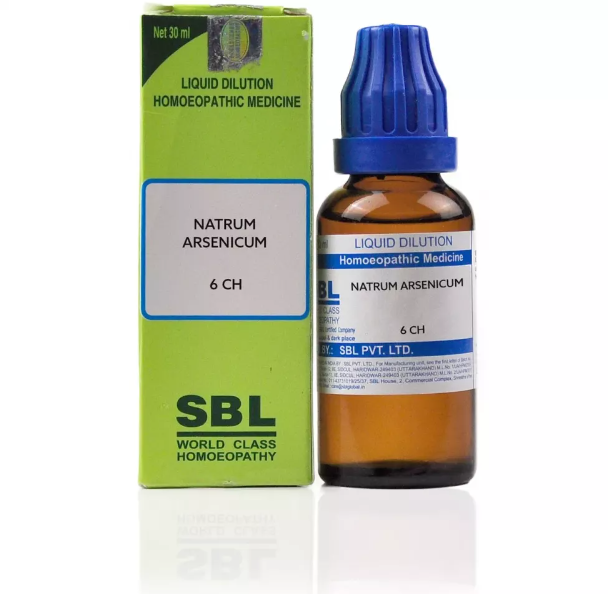NATRIUM ARSENICOSUM 6C, 12C, 30C, 200C, 1M, 10M USES AND SYMPTOMS
 NATRIUM ARSENICOSUM
NATRIUM ARSENICOSUM
(Arseniate of Sodium)
Nat-ar.
A remedy for nasal catarrh with headache, pain at the root of the nose, dry and painful eyes. Effective for psoriasis, bronchitis in children over seven years. It helps end colds and maintains strength and appetite (Cartier.).
Head: Floating sensation when turning the head quickly, aching in the frontal region and root of the nose, and over the orbits. Headache worsens with pressure and tobacco smoke.
Eyes: Catarrhal conjunctivitis and blepharitis marginalis. Eyes feel weak, stiff, and the lids tend to close. They feel heavy and droop (ptosis). Lachrymation occurs when exposed to wind. Eyes are agglutinated in the morning, dry, painful, burning, and tire easily. Edema in the orbital region and supraorbital pain.
Nose: Watery discharge that drops into the throat. Feels obstructed with pain at the root. Dry crusts leave the mucous membrane raw upon removal. Post-nasal dripping of thick, bland, yellowish mucus. Crusts in the nose.
Throat: Dark, purplish, swollen, edematous, red, and glassy (diphtheria).
Respiratory: Racking cough with profuse greenish expectoration. Oppression of the chest, around the heart, and in the larynx. Miner’s asthma. Lungs feel as though smoke has been inhaled.
Extremities: Aching in the arms, worse in the shoulder. Pain in the anterior crural nerves. Joints are stiff, the body feels tired all over, and knee joints crack (arthritis).
Relationship: Compare with Ars., Kali-c., Apis.
Dose: Third to thirtieth potency.
SYMPTOMS OF NATRIUM ARSENICOSUM
Head:
Floating sensation when turning the head quickly
Aching in the frontal region, root of the nose, and over the orbits
Headache worsens with pressure and tobacco smoke
Eyes:
Catarrhal conjunctivitis
Blepharitis marginalis
Weak, stiff eyes with a tendency for lids to close
Heavy, drooping eyelids (ptosis)
Lachrymation when exposed to wind
Agglutination in the morning
Dry, painful, burning eyes that tire easily
Edema in the orbital region
Supraorbital pain
Throat:
Dark, purplish, swollen, edematous throat
Red and glassy appearance (diphtheria)
Respiratory:
Racking cough with profuse greenish expectoration
Oppression of the chest, around the heart, and in the larynx
Miner’s asthma
Lungs feel as though smoke has been inhaled
Extremities:
Aching in the arms, worse in the shoulder
Pain in the anterior crural nerves
Stiff joints
General fatigue
Knee joints cracking (arthritis)
selection of the potency
Individualization:
- Homeopathy is based on the principle of treating the individual, not just the disease. The unique symptoms and characteristics of the person are crucial in determining the most suitable potency.
Intensity of Symptoms:
- The intensity of the symptoms guides the choice of potency. If the symptoms are intense and acute, a lower potency (e.g., 6C, 30C) might be considered. For chronic conditions with less intensity, higher potencies (e.g., 200C, 1M) may be appropriate.
Sensitivity of the Patient:
- Some individuals are more sensitive to homeopathic remedies, while others may require higher potencies. The practitioner considers the patient’s sensitivity when selecting the potency.
Acute vs. Chronic Conditions:
- Lower potencies are often used for acute conditions, while higher potencies may be considered for chronic or long-standing issues.
Previous Response to Potencies:
- The patient’s response to previous homeopathic treatments helps guide the choice of potency. If a particular potency has been effective in the past, it may be repeated or adjusted as needed.
Vital Force and Susceptibility:
- Homeopathy views illness as a disturbance in the vital force. The practitioner assesses the patient’s overall vitality and susceptibility to determine the appropriate potency.
Aggravation or Amelioration:
- The direction of the symptom response (aggravation or amelioration) after taking a remedy can influence the choice of potency.
Miasmatic Considerations:
- In classical homeopathy, the concept of miasms (inherited disease tendencies) is considered. The practitioner take this into account when selecting the potency.
Practitioner Experience:
- The experience and preference of the homeopathic practitioner play a role. Some practitioners may have success with certain potencies based on their clinical experience.
SAFETY INFORMATION
- Do not exceed the recommended dose by physician
- Keep out of the reach of children
- Store in a cool dry place away from direct sunlight
- Maintain half an hour gap between food/drink/any other medicines and homoeopathic medicine
- Avoid any strong smell in the mouth while taking medicine e.g. camphor, garlic, onion, coffee, hing
Medicine images use for reference only selection of homeopathic medicine depends on the individual’s specific symptoms and overall constitution. Moreover, homeopathy is a holistic system of medicine that treats the individual as a whole. In addition to addressing the physical symptoms, it takes into account the emotional and mental state of the person. Consequently, it’s crucial to consult with a qualified homeopathic practitioner for personalized treatment.
The information provided on this website is intended solely for educational purposes. Always seek the advice of your physician or other qualified health provider.
